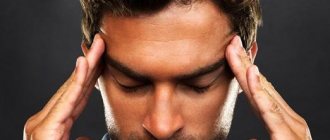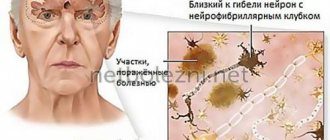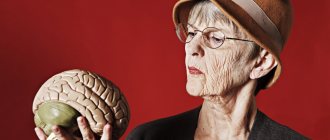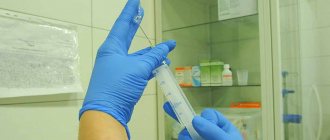Dementia is a condition characterized by persistent impairment of cognitive abilities. The disorder causes deterioration in memory, mental abilities, and orientation in time and space. Over time, people suffering from this disease cease to recognize loved ones and to be able to use devices and objects for their intended purpose. There is an inability to establish social contacts and communicate with others, to perform basic actions to satisfy one’s own physiological abilities. Patients complain of confusion, excessive suspicion and groundless aggression. signs and symptoms of senile dementia in yourself or someone you know , it is advisable to immediately consult a doctor.
How to identify dementia yourself?
The likelihood of developing dementia increases with age and is most common in people over 65 years of age. The disease is one of the factors causing significant limitations in the functional capabilities of older people. This condition is difficult to bear not only for the patient himself, but also for all his loved ones and society. A number of disorders that directly damage brain tissue can lead to the development of the disease:
- Alzheimer's disease;
- cardiovascular diseases;
- head injuries;
- malignant and benign tumors.
The course of the disease goes through several stages, during which the patient’s condition worsens with a certain intensity.
Mild dementia is characterized by symptoms traditionally associated with old age. Among them: mild memory impairment, difficulty performing complex tasks that require special attention or ingenuity.
With moderate dementia, the patient practically loses the ability of short-term memory, can easily lose the logic of a story, or experience difficulty making important decisions. This degree of development of the disorder occurs with pronounced physiological disturbances: sleep disorders, auditory and visual hallucinations, weakness and irritability. Senile pseudo-melancholy manifests itself - lack of emotion and indifference even to important events.
Severe dementia manifests itself in the patient’s inability to recognize even relatives, establish any contacts with others, or simply satisfy independently the basic needs necessary to maintain life.
Clock test
The dementia watch test is widely known, quite simple and informative, so it can be successfully used for the early detection of dementia. The person is given a blank piece of paper and a pencil, asked to draw a clock with a round dial and numbers on it, and also use the arrows to indicate the desired time (usually fifteen minutes to two).
The patient cannot use any hints, but must complete the task absolutely independently. The dementia clock test is assessed on a ten-point scale:
- 10 points correspond to the norm: a circle is depicted, the numbers are located correctly, and the arrows point to the numbers corresponding to the given time;
- 9 points if there are slight deviations in the position of the clock hands;
- 8 - significant deviations in the location of the arrows (one arrow is mistaken by more than one digit);
- 7 – large and small arrows are positioned incorrectly;
- 6 - arrows do not indicate time at all;
- 5 - numbers in the circle are arranged in reverse order or at different distances;
- 4 – the clock is not complete, since some numbers are missing, or they are located outside the circle;
- 3 — the clock face and numbers are not interconnected;
- 2 - a person tries to do a task to pass the test, but without any success;
- 1 - the subject does not try to do the exercise.
A test result of less than 9 points indicates severe impairments in memory and thinking. To clarify the diagnosis, a clock drawing test is performed to determine the degree of dementia, which is a simplified version of the exercise. In this case, the patient is given the task of drawing arrows indicating the desired time, already on the depicted dial with numbers. The severity of dementia is judged by the ability and quality of the task.
Dementia test: Can you pass it?
The SAGE test is a simple and effective diagnostic method that includes questions on logic, mathematical examples, as well as tasks on the preservation of perception and memory. When performing the test, you should refuse the help of special tools, instruments, devices - anything that will allow you to find out the correct answer.
The method is characterized by high sensitivity and low probability of erroneous results. You can carry out diagnostics yourself, without the help of specialists or loved ones.
If a patient complains of problems in the cognitive sphere and there is a suspicion of dementia, it is necessary to take measures to objectify disorders in the cognitive sphere: anamnesis, anamnesis of others, a primary neuropsychological examination.
To achieve this, the following procedures are used in daily practice.
| Try | Grade |
| 1. Time orientation: Name the date (day, month, year, day of the week, time of year) | 0 — 5 |
| 2. Place orientation: Where are we located? (country, region, city, clinic, floor) | 0 — 5 |
| 3.Perception: Repeat three words: pencil, house, penny | 0 — 3 |
| 4. Concentration and counting: Serial counting (“subtract 7 from 100”) - five times or: Say the word “earth” backwards | 0 — 5 |
| 5.Memory Remember 3 words (see point 3) | 0 — 3 |
| 6. Speech: Show a pen and a watch, ask: “What is this called?” Please repeat the sentence: “No ifs, ands, or buts.” | 0 — 3 |
| Execution of a 3-step command: “Take a piece of paper with your right hand, fold it in half and place it on the table.” | 0 — 3 |
| Reading: “Read and Complete” 1. Close your eyes 2. Write a sentence | 0 — 2 |
| 3. Draw the picture (*see below) | 0 — 1 |
| Total score: | 0-30 |
Instructions
1. Orientation in time. Ask the patient to fully state today's date, month, year and day of the week. The maximum score (5) is given if the patient independently and correctly names the date, month and year. If you have to ask additional questions, 4 points are given. Additional questions may be the following: if the patient only names the date, ask “What month?”, “What year?”, “What day of the week?”. Each error or lack of answer reduces the score by one point.
2. Orientation in place. The question is asked: “Where are we?” If the patient does not answer completely, additional questions are asked. The patient must name the country, region, city, institution in which the examination is taking place, room number (or floor). Each error or lack of answer reduces the score by one point.
3. Perception. The instruction is given: “Repeat and try to remember three words: pencil, house, penny.” Words should be pronounced as clearly as possible at a speed of one word per second. Correct repetition of a word by the patient is scored one point for each word. Words should be presented as many times as necessary for the subject to repeat them correctly. However, only the first repetition is scored.
4. Concentration. They are asked to subtract 7 from 100 in sequence, as this is described in 2.1.3.e. Five subtractions are enough (to the result “65”). Each mistake reduces the score by one point. Another option: they ask you to pronounce the word “earth” backwards. Each mistake reduces the score by one point. For example, if “yamlez” is pronounced instead of “yalmez”, 4 points are given; if “yamlze” - 3 points, etc.
5. Memory. The patient is asked to remember the words that were memorized in step 3. Each correctly named word is worth one point.
6. Speech. They show a pen and ask: “What is this?”, similarly - a watch. Each correct answer is worth one point.
The patient is asked to repeat the above grammatically complex phrase. Correct repetition is worth one point.
A command is given orally, which requires the sequential performance of three actions. Each action is worth one point.
Three written commands are given; the patient is asked to read them and complete them. Commands must be written in fairly large block letters on a blank sheet of paper. Correct execution of the second command requires that the patient independently write a meaningful and grammatically complete sentence. When performing the third command, the patient is given a sample (two intersecting pentagons with equal angles), which he must redraw on unlined paper. If spatial distortions or unconnected lines occur during redrawing, the execution of the command is considered incorrect. For correct execution of each command, one point is given.
Interpretation of results
The final score is obtained by summing the results for each item. The maximum score on this test is 30 points, which corresponds to the optimal state of cognitive functions. The lower the final score, the more severe the cognitive deficit. The test results can be interpreted as follows:
28 – 30 points – no impairment of cognitive functions;
24 – 27 points – pre-dementia cognitive impairment;
20 – 23 points – mild dementia;
11 – 19 points – moderate dementia;
0 – 10 points – severe dementia.
In terms of the number of tasks, the MMSE significantly exceeds other tests and requires more time to complete. In addition, experts note that the sensitivity of the test is quite low in the initial stages of dementia: the total score may remain within the normal range. In this case, the doctor can judge the presence of the disease by the dynamics of the results (compare the results shown at intervals of several months): if a person develops dementia, the results will worsen; in the absence of disease, the result shown will be stable.
The sensitivity of the test is also low for dementias with predominant damage to subcortical structures or the frontal lobes of the brain.
Since the MMSE test is a professional tool and is not intended for use by people without special training, we recommend using a questionnaire specially developed for this purpose by specialists at the University of Arizona to assess your loved one’s condition. It is 90% accurate in the early stages of dementia.
Assess your loved one's condition using the Arizona Questionnaire.
View other tests and scales.
Tags: #Dementia
Montreal Cognitive Assessment (MoCa)
This is a scale for determining the level of cognitive functions, used by specialists in everyday work. The Montreal Dementia Test consists of 30 questions, takes about 10-12 minutes and allows you to characterize the subject's:
- attention (repeat different sequences of numbers in forward and reverse order) and the ability to concentrate on something;
- executive functions (draw a line with the correct alternation of numbers and letters);
- memory (the ability to repeat five words spoken by the tester at different times);
- speech (correctly repeat two heard sentences and then name words starting with a specific letter);
- visual-constructive abilities (draw the shape of a cube);
- abstract thinking (during the test the patient must explain how two objects are similar);
- ability to calculate and count;
- orientation (asked to name today's date).
Important! Most dementia tests are comprehensive and measure multiple brain functions at once!
Also included in the Montreal Dementia Test are exercises for naming pictured animals and drawing a clock.
A test score of 26 to 30 (maximum) is the norm. If the result is less, then the person being studied has cognitive impairment to some degree.
Tips and warnings
Simple and enjoyable activities should be included in your daily to-do list, because with a complex effect they will help in activating mental activity:
- Walking - just walking 30-50 minutes a day is enough to improve blood circulation to the brain by 15%;
- Reading - to form new synapses, you should read at least 1 hour daily;
- Fiber - at least 10-15 g of it must be present in food to ensure a sufficient level of metabolism (nuts, oatmeal, vegetables);
- Learning languages - in those who know 2 or more languages, Alzheimer's disease is much less common and develops later;
- Positive emotions - they can stimulate the production of dopamine, which provides good memory.
You can strengthen your brain function not only with natural techniques and methods, but also with special synthetic drugs
However, in both the first and second cases, it is important to maintain a balance between the means used and the body’s reserves. And when using medications, also get advice from a qualified specialist
Sources
- Boyko, S. S. Pharmacokinetics of nootropic drugs / S. S. Boyko, G. Yu. Vitskova, V. P. Zherdev // Experiment. and wedge, pharmacology. -1997.-No. 6.
- Dittmann-Kohli, F., Lachman, M. E., Kliegl, R., & Baltes, P. B. (1991). Effects of cognitive training and testing on intellectual efficacy beliefs in elderly adults. Journal of Gerontology, 46,162-164.doi:10.1093/geronj/46.4.P162
- Schwarzer, R., & Jerusalem, M. (1995). Generalized Self-Efficacy Scale. In: J. Weinman, S. Wright, & M. Johnson (Eds.), Measures in health psychology: A user's portfolio, Causal and control beliefs (pp. 35–37). Windsor, England: Nfer-Nelson.
- Voronina, T. A. New directions in the search for nootropic drugs / T. A. Voronina // Vestn. RAMS. 1998. - No. 11.
- Bluck, S. (2003). Autobiographical memory: Exploring its functions in everyday life. Memory, 11 (2), 113 – 123. doi: 10.1080/741938206
- Dan Hurley. Get smarter 1167K, 291 pp. 2014 edition
SAGE testing
The SAGE (Self Administrated Gerocognitive Exam) test for dementia is highly sensitive. The test allows you to detect developing dementia at the earliest stages.
SAGE
The test taker is asked questions; a point is awarded for the correct answer (indicated in parentheses); for errors, 1 point is deducted:
- Name the day (2), month (1), year (1).
- Show 2 pictures and ask to name what is shown on them (2).
- How are a clock and a ruler similar? What do both items (1) contain?
- How many five-ruble coins do you need to collect 60 rubles (1)?
- How much change will you get from 20 rubles after making a purchase for 12 rubles 45 kopecks (1)?
- On the last page of the test, write in the blank line: “I did” (score in paragraph 12).
- Draw a three-dimensional cube according to the proposed model (2).
- Draw a dial and mark the hours. Show position 15 minutes past eleven. Mark the short hand and long hand of the clock on the dial (2).
- Write the names of 12 different animals (2).
- Connect numbers and letters of the alphabet sequentially with lines in ascending order (2).
In paragraph 10, on a sheet of paper, mark the numbers 1, 2, 3, 4, 5 and the letters of the alphabet. In the Russian version, the letters “A, B, V, G, D” are used. It is required to draw lines from number to letter in ascending order. The result should be a chain “1-A-2-B-3-C-4-D-5-D”.
If all tasks are completed correctly, clause 11 (2) is additionally suggested. In the drawn geometric figure you need to do one of the following:
- remove 2 lines, so as to get, for example, two triangles;
- change the shape to get 2 squares.
In paragraph 12 (2) it is proposed to accurately formulate the answer to the question: “Are you finished?”
For answers to the SAGE test, the maximum possible score is 22. If the score is 17-22, it is considered that there are no mental disorders.
A score of 15-16 indicates mild mental impairment. When the test total is less than 14, the person is considered to have dementia.
Diagnostics
The disease is diagnosed after a comprehensive examination of the personality and brain. Which doctor makes the diagnosis - a neurologist.
Diagnostic criteria:
- Obligate (mandatory) symptoms. Memory disorder, plus impairment of one of the following functions: speech, praxis, optical-spatial orientation, thinking.
- Signs are present in the clinical picture for at least 6 months.
- Symptoms are characterized by increasing dynamics.
- In the clinical picture there are no syndromes associated with impaired consciousness (twilight stupor, stupor, stupor).
MRI for dementia depends on the cause. Thus, in images of a patient with Alzheimer's dementia, atrophy is observed in the temporal cortex and around the hippocampus. Brain imaging of patients with Lewy body dementia shows atrophy of the frontal gyri.
Differential diagnosis of dementia is carried out with the following diseases:
- With primary organic pathologies: Parkinson's disease, multisystem degeneration, progressive supranuclear palsy.
- A disease within the class of endogenous organic diseases itself: vascular dementia, Alzheimer's type dementia, dementia with Lewy bodies.
- Pick's disease.
- Hydrocephalic dementia.
- Brain tumors.
See also: dementia in the elderly.











